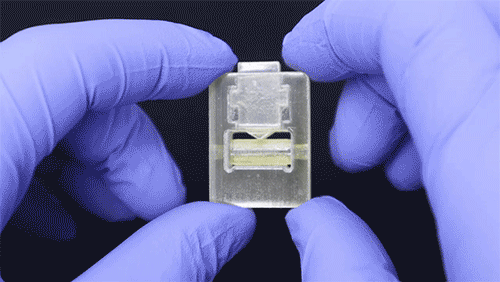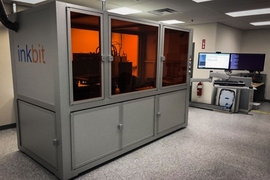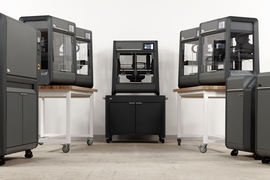Objects made with 3-D printing can be lighter, stronger, and more complex than those produced through traditional manufacturing methods. But several technical challenges must be overcome before 3-D printing transforms the production of most devices.
Commercially available printers generally offer only high speed, high precision, or high-quality materials. Rarely do they offer all three, limiting their usefulness as a manufacturing tool. Today, 3-D printing is used mainly for prototyping and low-volume production of specialized parts.
Now Inkbit, a startup out of MIT, is working to bring all of the benefits of 3-D printing to a slew of products that have never been printed before — and it’s aiming to do so at volumes that would radically disrupt production processes in a variety of industries.
The company is accomplishing this by pairing its multimaterial inkjet 3-D printer with machine-vision and machine-learning systems. The vision system comprehensively scans each layer of the object as it’s being printed to correct errors in real-time, while the machine-learning system uses that information to predict the warping behavior of materials and make more accurate final products.
“The company was born out of the idea of endowing a 3-D printer with eyes and brains,” says Inkbit co-founder and CEO Davide Marini PhD ’03.
That idea unlocks a range of applications for Inkbit’s machine. The company says it can print more flexible materials much more accurately than other printers. If an object, including a computer chip or other electronic component, is placed on the print area, the machine can precisely print materials around it. And when an object is complete, the machine keeps a digital replica that can be used for quality assurance.
Inkbit is still an early-stage company. It currently has one operational production-grade printer. But it will begin selling printed products later this year, starting with a pilot with Johnson and Johnson, before selling its printers next year. If Inkbit can leverage current interest from companies that sell medical devices, consumer products, and automotive components, its machines will be playing a leading production role in a host of multi-billion-dollar markets in the next few years, from dental aligners to industrial tooling and sleep apnea masks.
“Everyone knows the advantages of 3-D printing are enormous,” Marini says. “But most people are experiencing problems adopting it. The technology just isn’t there yet. Our machine is the first one that can learn the properties of a material and predict its behavior. I believe it will be transformative, because it will enable anyone to go from an idea to a usable product extremely quickly. It opens up business opportunities for everyone.”
A printer with potential
Some of the hardest materials to print today are also the most commonly used in current manufacturing processes. That includes rubber-like materials such as silicone, and high-temperature materials such as epoxy, which are often used for insulating electronics and in a variety of consumer, health, and industrial products.
These materials are usually difficult to print, leading to uneven distribution and print process failures like clogging. They also tend to shrink or round at the edges over time. Inkbit co-founders Wojciech Matusik, an associate professor of electrical engineering and computer science, Javier Ramos ’12 SM ’14, Wenshou Wang, and Kiril Vidimče SM ’14 have been working on these problems for years in Matusik’s Computational Fabrications Group within the Computer Science and Artificial Intelligence Laboratory (CSAIL).
In 2015, the co-founders were among a group of researchers that created a relatively low-cost, precise 3-D printer that could print a record 10 materials at once by leveraging machine vision. The feat got the attention of many large companies interested in transitioning production to 3-D printing, and the following year the four engineers received support from the Deshpande Center to commercialize their idea of joining machine vision with 3-D printing.
At MIT, Matusik’s research group used a simple 3-D scanner to track its machine’s progress. For Inkbit’s first printer, the founders wanted to dramatically improve “the eyes” of their machine. They decided to use an optical coherence tomography (OCT) scanner, which uses long wavelengths of light to see through the surface of materials and scan layers of material at a resolution the fraction of the width of a human hair.
Because OCT scanners are traditionally only used by ophthalmologists to examine below the surface of patients’ eyes, the only ones available were far too slow to scan each layer of a 3-D printed part — so Inkbit’s team “bit the bullet,” as Marini describes it, and built a custom OCT scanner he says is 100 times faster than anything else on the market today.
When a layer is printed and scanned, the company’s proprietary machine-vision and machine-learning systems automatically correct any errors in real-time and proactively compensate for the warping and shrinkage behavior of a fickle material. Those processes further expand the range of materials the company is able to print with by removing the rollers and scrapers used by some other printers to ensure precision, which tend to jam when used with difficult-to-print materials.
The system is designed to allow users to prototype and manufacture new objects on the same machine. Inkbit’s current industrial printer has 16 print heads to create multimaterial parts and a print block big enough to produce hundreds of thousands of fist-sized products each year (or smaller numbers of larger products). The machine’s contactless inkjet design means increasing the size of later iterations will be as simple as expanding the print block.
“Before, people could make prototypes with multimaterial printers, but they couldn’t really manufacture final parts,” Matusik says, noting that the postprocessing of Inkbit’s parts can be fully automated. “This is something that’s not possible using any other manufacturing methods.”

Inkbit's 3-D printer can produce multimaterial objects (like the pinch valve shown above) at high volumes. Courtesy of Inkbit
The novel capabilities of Inkbit’s machine mean that some of the materials the founders want to print with are not available, so the company has created some of its own chemistries to push the performance of their products to the limit. A proprietary system for mixing two materials just before printing will be available on the printers Inkbit ships next year. The two-part chemistry mixing system will allow the company to print a broader range of engineering-grade materials.
Johnson and Johnson, a strategic partner of Inkbit, is in the process of acquiring one of the first printers. The MIT Startup Exchange Accelerator (STEX25) has also been instrumental in exposing Inkbit to leading corporations such as Amgen, Asics, BAE Systems, Bosch, Chanel, Lockheed Martin, Medtronic, Novartis, and others.
Today, the founders spend a lot of their time educating product design teams that have never been able to 3-D print their products before — let alone incorporate electronic components into 3-D-printed parts.
It may be a while before designers and inventors take full advantage of the possibilities unlocked by integrated, multimaterial 3-D printing. But for now, Inkbit is working to ensure that, when that future comes, the most imaginative people will have a machine to work with.
“Some of this is so far ahead of its time,” Matusik says. “I think it will be really fascinating to see how people are going to use it for final products.”










